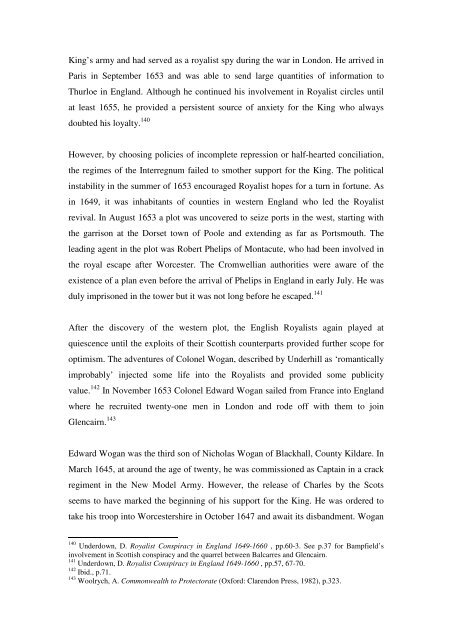The Glencairn Uprising, 1653-54 Helen Baker Department of ...
The Glencairn Uprising, 1653-54 Helen Baker Department of ...
The Glencairn Uprising, 1653-54 Helen Baker Department of ...
You also want an ePaper? Increase the reach of your titles
YUMPU automatically turns print PDFs into web optimized ePapers that Google loves.
King’s army and had served as a royalist spy during the war in London. He arrived in<br />
Paris in September <strong>1653</strong> and was able to send large quantities <strong>of</strong> information to<br />
Thurloe in England. Although he continued his involvement in Royalist circles until<br />
at least 1655, he provided a persistent source <strong>of</strong> anxiety for the King who always<br />
doubted his loyalty. 140<br />
However, by choosing policies <strong>of</strong> incomplete repression or half-hearted conciliation,<br />
the regimes <strong>of</strong> the Interregnum failed to smother support for the King. <strong>The</strong> political<br />
instability in the summer <strong>of</strong> <strong>1653</strong> encouraged Royalist hopes for a turn in fortune. As<br />
in 1649, it was inhabitants <strong>of</strong> counties in western England who led the Royalist<br />
revival. In August <strong>1653</strong> a plot was uncovered to seize ports in the west, starting with<br />
the garrison at the Dorset town <strong>of</strong> Poole and extending as far as Portsmouth. <strong>The</strong><br />
leading agent in the plot was Robert Phelips <strong>of</strong> Montacute, who had been involved in<br />
the royal escape after Worcester. <strong>The</strong> Cromwellian authorities were aware <strong>of</strong> the<br />
existence <strong>of</strong> a plan even before the arrival <strong>of</strong> Phelips in England in early July. He was<br />
duly imprisoned in the tower but it was not long before he escaped. 141<br />
After the discovery <strong>of</strong> the western plot, the English Royalists again played at<br />
quiescence until the exploits <strong>of</strong> their Scottish counterparts provided further scope for<br />
optimism. <strong>The</strong> adventures <strong>of</strong> Colonel Wogan, described by Underhill as ‘romantically<br />
improbably’ injected some life into the Royalists and provided some publicity<br />
value. 142 In November <strong>1653</strong> Colonel Edward Wogan sailed from France into England<br />
where he recruited twenty-one men in London and rode <strong>of</strong>f with them to join<br />
<strong>Glencairn</strong>. 143<br />
Edward Wogan was the third son <strong>of</strong> Nicholas Wogan <strong>of</strong> Blackhall, County Kildare. In<br />
March 1645, at around the age <strong>of</strong> twenty, he was commissioned as Captain in a crack<br />
regiment in the New Model Army. However, the release <strong>of</strong> Charles by the Scots<br />
seems to have marked the beginning <strong>of</strong> his support for the King. He was ordered to<br />
take his troop into Worcestershire in October 1647 and await its disbandment. Wogan<br />
140 Underdown, D. Royalist Conspiracy in England 1649-1660 , pp.60-3. See p.37 for Bampfield’s<br />
involvement in Scottish conspiracy and the quarrel between Balcarres and <strong>Glencairn</strong>.<br />
141 Underdown, D. Royalist Conspiracy in England 1649-1660 , pp.57, 67-70.<br />
142 Ibid., p.71.<br />
143 Woolrych, A. Commonwealth to Protectorate (Oxford: Clarendon Press, 1982), p.323.
















